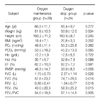Abstract
Background
Despite the benefits of home oxygen therapy in patients suffering chronic respiratory failure, previous reports in Korea revealed lower compliance to oxygen therapy and a shorter time for oxygen use than expected. However, these papers were published before oxygen therapy was covered by the national insurance system. Therefore, this study examined whether there were some changes in compliance, using time and other clinical features of home oxygen therapy after insurance coverage.
Methods
This study reviewed the medical records of patients prescribed home oxygen therapy in our hospital from November 1, 2006 to September 31, 2008. The patients were interviewed either in person or by telephone to obtain information related to oxygen therapy.
Results
During study period, a total 105 patients started home oxygen therapy. The mean age was 69 and 60 (57%) were male. The mean oxygen partial pressure in the arterial blood was 54.5 mmHg and oxygen saturation was 86.3%. Primary diseases that caused hypoxemia were COPD (n=64), lung cancer (n=14), Tb destroyed lung (n=12) and others. After oxygen therapy, more than 50% of patients experienced relief of their subjective dyspnea. The mean daily use of oxygen was 9.8±7.3 hours and oxygen was not used during activity outside of their home (mean time, 5.4±3.7 hours). Twenty four patients (36%) stopped using oxygen voluntarily 7±4.7 months after being prescribed oxygen and showed a less severe pulmonary and right heart function. The causes of stopping were subjective symptom relief (n=11), inconvenience (n=6) and others (7).
Conclusion
The prescription of home oxygen has increased since national insurance started to cover home oxygen therapy. However, the mean time for using oxygen is still shorter than expected. During activity of outside their home, patients could not use oxygen due to the absence of portable oxygen. Overall, continuous education to change the misunderstandings about oxygen therapy, more economic support from national insurance and coverage for portable oxygen are needed to extend the oxygen use time and maintain oxygen usage.
Figures and Tables
References
1. Cotes JE, Gilson JC. Effect of oxygen on exercise ability in chronic respiratory insufficiency: use of portable apparatus. Lancet. 1956. 270:872–876.
2. Stark RD, Finnegan P, Bishop JM. Daily requirement of oxygen to reverse pulmonary hypertension in patients with chronic bronchitis. Br Med J. 1972. 3:724–728.
3. Stewart BN, Hood CI, Block AJ. Long-term results of continuous oxygen therapy at sea level. Chest. 1975. 68:486–492.
4. Petty TL, Nett LM, Finigan MM, Brink GA, Corsello PR. A comprehensive care program for chronic airway obstruction: methods and preliminary evaluation of symptomatic and functional improvement. Ann Intern Med. 1969. 70:1109–1120.
5. Nocturnal Oxygen Therapy Trial Groups. Continuous or nocturnal oxygen therapy in hypoxemic chronic obstructive lung disease: a clinical trial. Ann Intern Med. 1980. 93:391–398.
6. Fulmer JD, Snider GL. ACCP-NHLBI National Conference on Oxygen Therapy. Chest. 1984. 86:234–247.
7. Guyatt GH, McKim DA, Austin P, Bryan R, Norgren J, Weaver B, et al. Appropriateness of domiciliary oxygen delivery. Chest. 2000. 118:1303–1308.
8. Chaney JC, Jones K, Grathwohl K, Olivier KN. Implementation of an oxygen therapy clinic to manage users of long-term oxygen therapy. Chest. 2002. 122:1661–1667.
9. Huh JW, Lee JY, Hong SB, Oh YM, Shim TS, Lim CM, et al. Long-term oxygen therapy in patients with chronic respiratory failure in one university hospital. Tuberc Respir Dis. 2005. 58:160–166.
10. Lee YS, Cha SI, Han CD, Kim CH, Kim YJ, Park JY, et al. Clinical experience of long-term home oxygen therapy. Tuberc Respir Dis. 1993. 40:283–291.
11. AARC. AARC clinical practice guideline. Oxygen therapy in the home or alternate site health care facility-2007 revision & update. Respir Care. 2007. 52:1063–1068.
12. The Korean Academy of Tuberculosis and Respiratory Disease. Clinical practice guideline of chronic obstructive lung disease. 2005. 1st ed. Seoul: The Korean Academy of Tuberculosis and Respiratory Disease.




 PDF
PDF ePub
ePub Citation
Citation Print
Print







 XML Download
XML Download